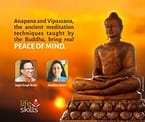“There is, monks, this one way to the purification of beings, for the overcoming of sorrow and distress, for the disappearance of pain and sadness, for the gaining of the right path, for the realization of Nibbana—that is to say, the four foundations of mindfulness.” — Buddha
The Path of Insight
Vipassana, meaning to see things as they truly are, is a structured and logical approach to meditation, leading to deep inner peace and liberation from suffering. The Buddha taught this method after his enlightenment, guiding thousands to freedom from misery through self-awareness and mindfulness.
Meditation is at the heart of the Buddha’s teaching. It is the direct path to Nibbana, achieved by observing the body, feelings, mind, and phenomena with full awareness and insight. By diligently practicing the four foundations of mindfulness, one transcends suffering and attains profound wisdom.
“Bhikkhus, these four establishments of mindfulness, when developed and cultivated, lead to going beyond from the near shore to the far shore.”
One must dwell observing reality with clarity, free from craving and aversion, and with full comprehension of impermanence.
Observing the Body
- Find a quiet place, sit cross-legged with a straight back, and close your eyes.
- Observe the breath, noticing whether it is deep or shallow.
- Be fully aware of bodily actions—walking, sitting, lying down, moving, eating, drinking.
- Maintain mindfulness in every action and posture.
This is how one dwells observing the body in the body.
Observing Sensations
- Be aware of sensations as they arise: pleasant, unpleasant, or neutral.
- Observe whether these sensations are met with attachment or detachment.
- Recognize them without reacting.
This is how one dwells observing feelings in feelings.
Observing the Mind
- Recognize the nature of the mind:
- A mind with craving or without craving.
- A mind with aversion or without aversion.
- A mind with delusion or free from delusion.
- A concentrated mind or scattered mind.
- A liberated mind or unliberated mind.
This is how one dwells observing the mind in the mind.
Observing Phenomena
- Observe mental formations, such as:
- The five hindrances (desire, aversion, dullness, restlessness, doubt).
- The five aggregates of clinging (form, feeling, perception, mental formations, consciousness).
- The six sense bases (eye and forms, ear and sounds, etc.), understanding how fetters arise and are abandoned.
- The seven factors of enlightenment (mindfulness, investigation, effort, rapture, tranquillity, concentration, equanimity).
- The Four Noble Truths—suffering, its cause, its cessation, and the path leading to its cessation.
This is how one dwells observing mental contents in mental contents.
The Power of Mindfulness
By developing the four foundations of mindfulness, one may expect either:
- Final knowledge (liberation) here and now, or
- If residual clinging remains, the state of non-returning.
“Bhikkhus, just as the river Ganges slants, slopes, and inclines towards the east, so too a bhikkhu who develops and cultivates the four jhanas slants, slopes, and inclines towards Nibbana.”
Thus, the four foundations of mindfulness serve as the direct path to purification, wisdom, and liberation from suffering.
♥ ♥ ♥ ♥
Please click on the following links to read previously published posts “Meditate Like The Buddha: A Step-By-Step Guide” 👉
☆ Meditate Like The Buddha #1: A Step-By-Step Guide ☆ Mr. Jagat Singh Bisht ☆
☆ Meditate Like The Buddha #2: The First Step ☆ Mr. Jagat Singh Bisht ☆
☆ Meditate Like The Buddha #3: Watch Your Breath ☆ Mr. Jagat Singh Bisht ☆
☆ Meditate Like The Buddha #4: Relax Your Body ☆ Mr. Jagat Singh Bisht ☆
☆ Meditate Like The Buddha #5: Cultivate Loving kindness ☆ Mr. Jagat Singh Bisht ☆
☆ Meditate Like The Buddha # 6: Experience your feelings ☆ Mr. Jagat Singh Bisht ☆
☆ Meditate Like The Buddha # 7: Tranquilize Mental Formations☆ Mr. Jagat Singh Bisht ☆
English Literature – Articles ☆ Meditate Like The Buddha # 8: Midway Recap ☆ Mr. Jagat Singh Bisht ☆
© Jagat Singh Bisht
Laughter Yoga Master Trainer
FounderLifeSkills
A Pathway to Authentic Happiness, Well-Being & A Fulfilling Life! We teach skills to lead a healthy, happy and meaningful life.
The Science of Happiness (Positive Psychology), Meditation, Yoga, Spirituality and Laughter Yoga. We conduct talks, seminars, workshops, retreats and training.
≈ Editor – Shri Hemant Bawankar/Editor (English) – Captain Pravin Raghuvanshi, NM





